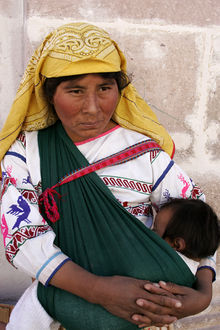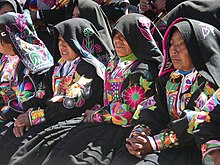Indigenous women of the Americas
Quotes about women of the Indigenous peoples of the Americas.


Quotes
edit- The physical and cultural genocide of American Indian tribes is and was mostly about patriarchal fear of gynocracy. The Puritans particularly, but also the Catholic, Quaker, and other Christian missionaries, like their secular counterparts, could not tolerate peoples who allowed women to occupy prominent positions and decision-making capacity at every level of society. Wives telling husbands and brothers whether to buy or sell an item, daughters telling fathers whom they could and could not murder, empresses attending parleys with colonizers and being treated with deference by male leaders did not sit well with the invaders. The colonizers saw (and rightly) that as long as women held unquestioned power of such magnitude, attempts at total conquest of the continents were bound to fail. In the centuries since the first attempts at colonization in the early 1500s, the invaders have exerted every effort to remove Indian women from every position of authority, to obliterate all records pertaining to gynocratic social systems, and to ensure that no American and few American Indians would remember that gynocracy was the primary social order of Indian America prior to 1800.
- Paula Gunn Allen, The Sacred Hoop: Recovering the Feminine in American Indian Traditions. Beacon Press. 1 September 1992. ISBN 978-0-8070-4617-3. Introduction
- Pre-Conquest American Indian women valued their role as vitalizers. Through their own bodies they could bring vital beings into the world—a miraculous power whose potency does not diminish with industrial sophistication or time. They were mothers, and that word did not imply slaves, drudges, drones who are required to live only for others rather than for themselves as it does so tragically for many modern women. The ancient ones were empowered by their certain knowledge that the power to make life is the source of all power and that no other power can gainsay it. Nor is that power simply of biology, as modernists tendentiously believe.
- Paula Gunn Allen, The Sacred Hoop: Recovering the Feminine in American Indian Traditions. Beacon Press. 1 September 1992. ISBN 978-0-8070-4617-3. Chapter One
- Modern American Indian women, like their non-Indian sisters, are deeply engaged in the struggle to redefine themselves. In their struggle they must reconcile traditional tribal definitions of women with industrial and postindustrial non-Indian definitions. Yet while these definitions seem to be more or less mutually exclusive, Indian women must somehow harmonize and integrate both in their own lives. An American Indian woman is primarily defined by her tribal identity. In her eyes, her destiny is necessarily that of her people, and her sense of herself as a woman is first and foremost prescribed by her tribe. The definitions of woman’s roles are as diverse as tribal cultures in the Americas. In some she is devalued, in others she wields considerable power. In some she is a familial/clan adjunct, in some she is as close to autonomous as her economic circumstances and psychological traits permit. But in no tribal definitions is she perceived in the same way as are women in western industrial and postindustrial cultures.
- Paula Gunn Allen, The Sacred Hoop: Recovering the Feminine in American Indian Traditions. Beacon Press. 1 September 1992. ISBN 978-0-8070-4617-3. Chapter One
- The tribes see women variously, but they do not question the power of femininity. Sometimes they see women as fearful, sometimes peaceful, sometimes omnipotent and omniscient, but they never portray women as mindless, helpless, simple, or oppressed. And while the women in a given tribe, clan, or band may be all these things, the individual woman is provided with a variety of images of women from the interconnected supernatural, natural, and social worlds she lives in.
- Paula Gunn Allen, The Sacred Hoop: Recovering the Feminine in American Indian Traditions. Beacon Press. 1 September 1992. ISBN 978-0-8070-4617-3. Chapter One
- The oral tradition is vital; it heals itself and the tribal web by adapting to the flow of the present while never relinquishing its connection to the past. Its adaptability has always been required, as many generations have experienced. Certainly the modern American Indian woman bears slight resemblance to her forebears—at least on superficial examination—but she is still a tribal woman in her deepest being. Her tribal sense of relationship to all that is continues to flourish. And though she is at times beset by her knowledge of the enormous gap between the life she lives and the life she was raised to live, and while she adapts her mind and being to the circumstances of her present life, she does so in tribal ways, mending the tears in the web of being from which she takes her existence as she goes.
- Paula Gunn Allen, The Sacred Hoop: Recovering the Feminine in American Indian Traditions. Beacon Press. 1 September 1992. ISBN 978-0-8070-4617-3. Chapter One
- Most Indian women I know are in the same bicultural bind: we vacillate between being dependent and strong, self-reliant and powerless, strongly motivated and hopelessly insecure. We resolve the dilemma in various ways: some of us party all the time; some of us drink to excess; some of us travel and move around a lot; some of us land good jobs and then quit them; some of us engage in violent exchanges; some of us blow our brains out. We act in these destructive ways because we suffer from the societal conflicts caused by having to identify with two hopelessly opposed cultural definitions of women. Through this destructive dissonance we are unhappy prey to the self-disparagement common to, indeed demanded of, Indians living in the United States today. Our situation is caused by the exigencies of a history of invasion, conquest, and colonization whose searing marks are probably ineradicable. A popular bumper sticker on many Indian cars proclaims: “If You’re Indian You’re In,” to which I always find myself adding under my breath, “Trouble.”
- Paula Gunn Allen, The Sacred Hoop: Recovering the Feminine in American Indian Traditions. Beacon Press. 1 September 1992. ISBN 978-0-8070-4617-3. Chapter One
- Through all the centuries of war and death and cultural and psychic destruction have endured the women who raise the children and tend the fires, who pass along the tales and the traditions, who weep and bury the dead, who are the dead, and who never forget. There are always the women, who make pots and weave baskets, who fashion clothes and cheer their children on at powwow, who make fry bread and piki bread, and corn soup and chili stew, who dance and sing and remember and hold within their hearts the dream of their ancient peoples—that one day the woman who thinks will speak to us again, and everywhere there will be peace.
- Paula Gunn Allen, The Sacred Hoop: Recovering the Feminine in American Indian Traditions. Beacon Press. 1 September 1992. ISBN 978-0-8070-4617-3. Chapter One
- The years between time immemorial and the present are long and bloody and filled with despair. But we cannot despair, we children of the mother, Earth Woman, and the grandmother, Thought Woman. American Indian women not only have endured, but we have grown stronger and more hopeful in the past decade. Our numbers grow, our determination to define ourselves grows, and our consciousness of our situation, of the forces affecting it, and of the steps we can take to turn our situation around grows.
- Paula Gunn Allen, The Sacred Hoop: Recovering the Feminine in American Indian Traditions. Beacon Press. 1 September 1992. ISBN 978-0-8070-4617-3. Chapter Three
- American Indian women struggle on every front for the survival of our children, our people, our self-respect, our value systems, and our way of life. The past five hundred years testify to our skill at waging this struggle: for all the varied weapons of extinction pointed at our heads, we endure. We survive war and conquest; we survive colonization, acculturation, assimilation; we survive beating, rape, starvation, mutilation, sterilization, abandonment, neglect, death of our children, our loved ones, destruction of our land, our homes, our past, and our future. We survive, and we do more than just survive. We bond, we care, we fight, we teach, we nurse, we bear, we feed, we earn, we laugh, we love, we hang in there, no matter what.
- Paula Gunn Allen, The Sacred Hoop: Recovering the Feminine in American Indian Traditions. Beacon Press. 1 September 1992. ISBN 978-0-8070-4617-3. Chapter Three
External links
edit- Encyclopedic article on Gender roles among the Indigenous peoples of North America on Wikipedia
- Encyclopedic article on Native American women in Colonial America on Wikipedia
- Encyclopedic article on List of Native American women of the United States on Wikipedia
- Encyclopedic article on Category:Indigenous women of the Americas on Wikipedia
- Indigenous Women and Their Human Rights in the Americas. Inter-American Commission on Human Rights. 17 April 2017. ISBN 978-0-8270-6659-5.